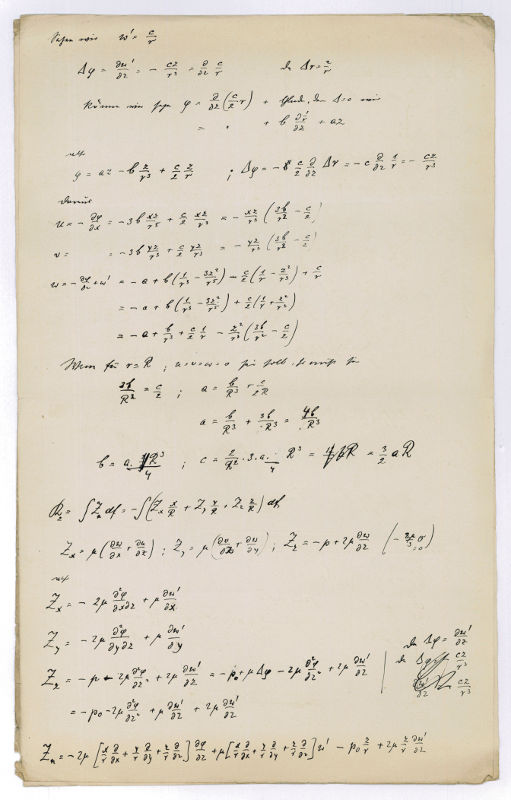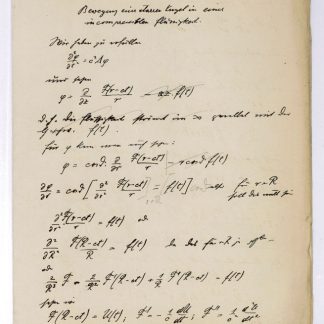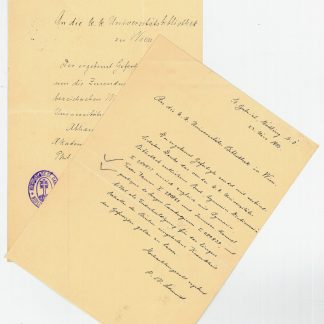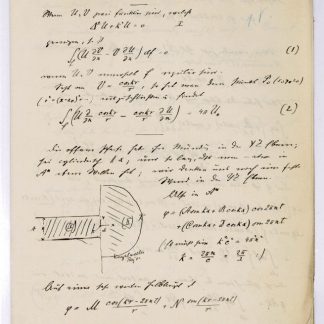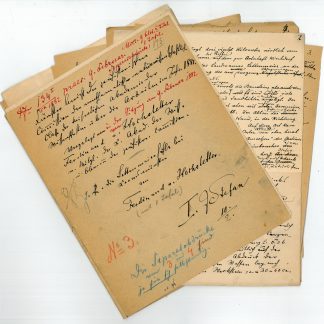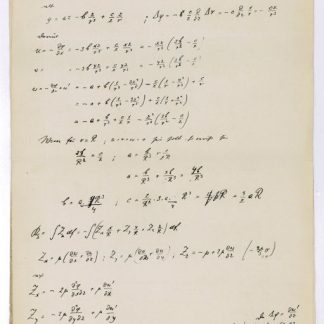Autogr. manuscript.
4 pp. in-folio and 1½ pp. in-4to. Black ink on paper; several pencil revisions.
€ 8,500.00
Discussing (inter alia) Poiseuille's Law and Stokes' Law; apparently penned in connection with Hasenöhrl's hydromechanics lecture (Mechanics II), which Hasenöhrl taught in the summer semesters of 1908, 1911, and 1914; possibly written for or during the concomitant seminar course. Pages 6 and 7 concern the theory of open and stopped pipes.
In his 1933 Nobel Prize acceptance speech, Erwin Schrödinger looked back on the gift of his teacher Hasenöhrl to discuss a subject matter in the lecture hall both extensively and closely: "The lecture cycle, which spanned eight semesters of five periods per week, treated the advanced theories of mechanics as well as the eigenvalue problems of continuum physics with the degree of detail that I would later need dearly - I have never been able to study from books with any ease [... He died in the War], and a feeling tells me that, but for that, it would be he who would be receiving this honor in my place today." In his 1904 treatise "On the Theory of Radiation in Moving Bodies", Hasenöhrl had applied the concept of "electromagnetic mass" to a cavity filled with radiation, arguing that any kind of thermal radiation provides such a body with an apparent increase of mass. This achievement, which makes the connection of energy and mass and - in its most radically compressed form "m = E/c²" - seems to anticipate Einstein's special theory of relativity, won Hasenöhrl the 1905 Haitinger Prize (at Boltzmann's suggestion) and was the basis for his appointment to the Vienna Chair of Physics the following year. In 1905, Einstein generalised Hasenöhrl's equation (which the latter had applied only to cavity radiation) and managed to embed it within an encompassing theory, thus arriving at the iconic "E=mc²" equation (for Hasenöhrl's role in the development of the equation cf. Stephen Boughn's recent article, "Fritz Hasenöhrl and E=mc²", in: The European Physical Journal H 38/1 [Jan. 2013], p. 1-18). Incidentally, Hasenöhrl taught Einstein's theory of relativity in his lectures - a highly uncommon course topic for the time. In 1911, Hasenöhrl participated in the historic first "Conseil Solvay", the invitation-only Brussels conference that united the world's elite of experimental and theoretical physicists to discuss the fundamental problems of their field. Themed "La théorie du rayonnement et les quanta", that first conference tackled the various approaches of classical physics and the emerging quantum theory; among the other participants were Einstein, Marie Curie, Ernest Rutherford, H. A. Lorentz, Wilhelm Wien, Heike Kamerlingh Onnes, and Henri Poincaré. Hasenöhrl also participated in the second Solvay Conference in 1913.
Edges slightly frayed and dusty, otherwise perfect. Of the utmost rarity: Hasenöhrl manuscripts are considered virtually unobtainable; auction records since 1975 list not a single leaf of writing in his hand (in contrast with more than 1000 records for Albert Einstein, more than 100 of which are manuscripts). The Göttingen State Library holds a 17-page transcript of Hasenöhrl's lecture on spherical functions (Cod. Ms. G. Herglotz E 15) in the hand of the student Gustav Herglotz (1881-1953), later professor of Mathematics at Leipzig and Göttingen. The Austrian Central Library of Physics keeps an archive of Hasenöhrl material: a single-box corpus containing mainly photographs, offprints, and photocopies of personal documents, but no manuscripts at all (with the exception of a single page of equations on the reverse of a letter from a bookseller). Several letters by Hasenöhrl are to be found in the personal archives of scholars (e. g., to Prof. Stefan Meyer, in the Archives of the Institute for Radium Research, Austrian Academy of Sciences).
Cf. Stephen Boughn, "Fritz Hasenöhrl and E=mc²", in: The European Physical Journal H 38/1 [Jan. 2013], p. 1-18.

